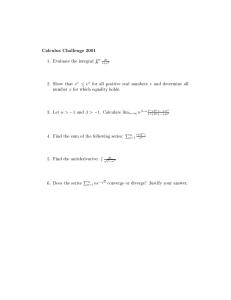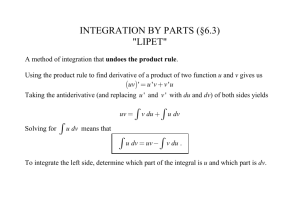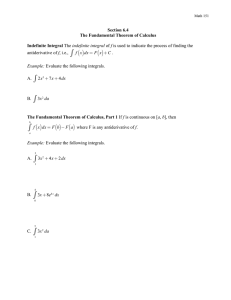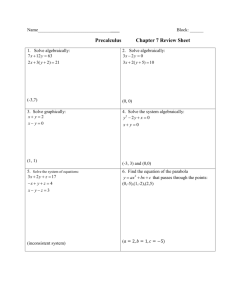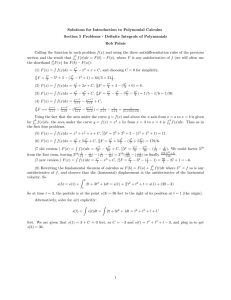Document 13555102
advertisement
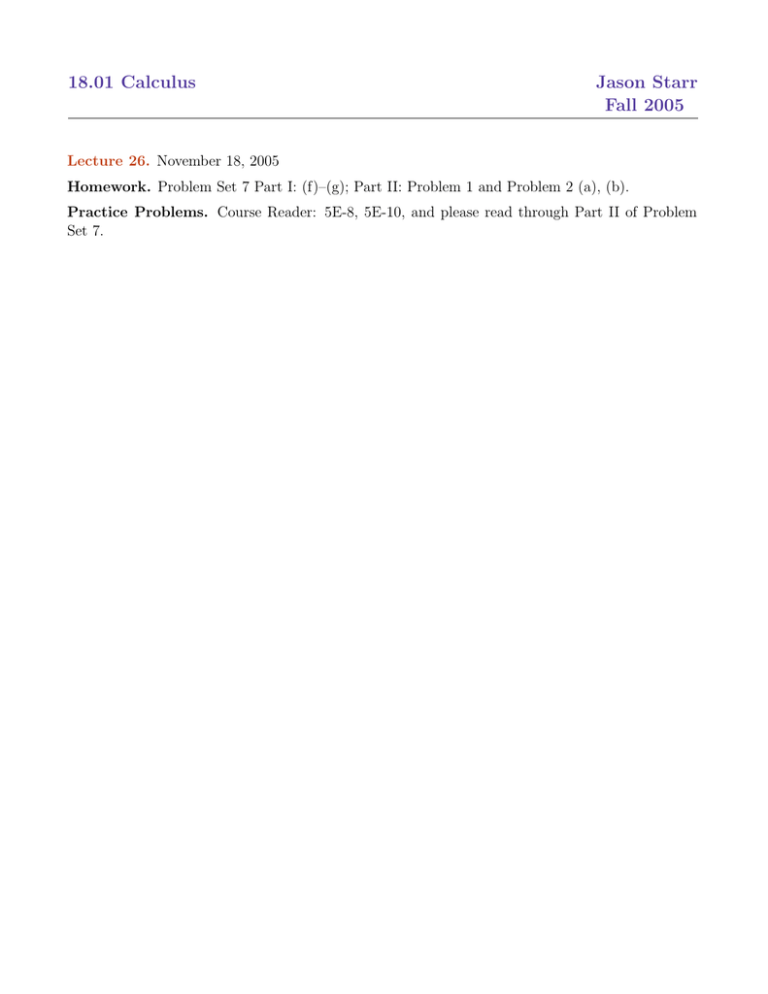
18.01 Calculus Jason Starr Fall 2005 Lecture 26. November 18, 2005 Homework. Problem Set 7 Part I: (f)–(g); Part II: Problem 1 and Problem 2 (a), (b). Practice Problems. Course Reader: 5E­8, 5E­10, and please read through Part II of Problem Set 7. 18.01 Calculus Jason Starr Fall 2005 1. Review of inverse substitution and another example. Recall the general strategy for finding an antiderivative of the form, √ � F (x, Ax2 + Bx + C) √ dx. G(x, Ax2 + Bx + C) For definiteness, consider the example, � √ x2 dx, x2 − 2ax + 2a2 where a is a constant. Step 1. Complete the square. Complete the square of the expression Ax2 + Bx + C, inside the radical. In the example, x2 − 2ax + 2a2 = (x − a)2 + a2 . Step 2. Make a linear change of coordinates. Make a linear change of coordinates to simplify the quadratic term to one of the 3 types: a2 − x2 , x2 − a2 , or x2 + a2 . In the example, this means making the linear change of variables, u = x − a, du = dx. The new quadratic term is u2 + a2 , the third type. The new antiderivative is, � � 2 (u + a)2 u + 2u + a2 √ √ du = du. u2 + a2 u 2 + a2 Step 3. Use inverse substitution to eliminate the radicals. There is a choice of inverse sub­ stitution: trigonometric, hyperbolic or rational. When starting out, it is a good idea to experiment with all 3. On an exam, usually one choice will be suggested (or even demanded). When no other guidance is given, trigonometric substitution is a good starting point (because you are already very familiar with trigonometric functions). In the example, to eliminate the radical, the correct inverse trigonometric substitution is, u = a tan(θ), du = a sec2 (θ)dθ. This is because the quadratic term becomes, u2 + a2 = a2 tan2 (θ) + a2 = a2 sec2 (θ). With this substitution, the new antiderivative is, � 2 a tan2 (θ) + 2a2 tan(θ) + a2 � a sec2 (θ)dθ. 2 2 a sec (θ) 18.01 Calculus Jason Starr Fall 2005 This simplifies to, 2 a � (tan2 (θ) + 2 tan(θ) + 1) sec(θ)dθ. This can be written as a sum of 3 terms, � � � 2 2 2 2 a tan (θ) sec(θ)dθ + 2a sec(θ) tan(θ)dθ + a sec(θ)dθ. Step 4. Compute the new antiderivative. If this were only as simple as it sounds, how much easier calculus would be! This step is often difficult in itself. Often it requires at least one more direct substitution. Sometimes, it also requires a partial fractions decomposition. We will return to this step below. Step 5. Back­substitute. This is always a step for a method using direct substitution or inverse substitution. This step frequently introduces terms like cos(tan−1 (x)). Time­permitting (or when specifically instructed to do so), these terms should be simplifed using the right­triangle method from lecture, √ θ = tan−1 (x), x/1 = tan(θ) = Opposite/Adjacent, Hypotenuse = 1 + x2 , √ cos(θ) = Adjacent/Hypotenuse = 1/ 1 + x2 . Step 6. Check your answer. When feasible, check your answer. Since differentiation is so much faster than antidifferentiation, it is usually quite easy to check an antiderivative is correct. Example. The tricky part is, of course, Step 4. In the example, the integral broke into 3 terms, � � � 2 2 2 2 a tan (θ) sec(θ)dθ + 2a sec(θ) tan(θ)dθ + a sec(θ)dθ. The last antiderivative was actually Problem 3(b) from Part II of Problem Set 4. It turns out to be, � √ √ 2 a sec(θ)dθ = a2 ln(u + u2 + a2 ) + C = a2 ln(x − a + x2 − 2ax + 2a2 ) + C. � The middle antiderivative is simply the derivative of sec(θ) = 1 + tan2 (θ). So the middle term is, � √ √ 2 2a sec(θ) tan(θ)dθ = 2a2 sec(θ) + C = 2a a2 + u2 + C = 2a x2 − 2ax + 2a2 + C. But the final term does not simplify in an obvious way. In such cases, it is best to express everything in terms of sin(θ) and cos(θ) to get a fresh perspective, � � sin2 (θ) 2 2 2 a tan (θ) sec(θ)dθ = a dθ. cos3 (θ) 18.01 Calculus Jason Starr Fall 2005 Multiplying numerator and denominator by cos(θ) and expressing in terms of sin(θ) gives, � � sin2 (θ) sin2 (θ) 2 2 cos(θ)dθ = a cos(θ)dθ. a (cos2 (θ))2 (1 − sin2 (θ))2 Now substitute for sin(θ), z = sin(θ), dz = cos(θ)dθ. The new antiderivative is, � z2 dz. (1 − z 2 )2 How do we compute this antiderivative? That is the topic of partial fractions. Remark: In lecture the solution was done a bit differently. This led to a slightly different an­ tiderivative, � 1 dz. (1 − z 2 )2 Notice the difference of these 2 antiderivatives is, � � (1) − (z 2 ) 1 dz = dz. (1 − z 2 )2 (1 − z 2 ) This was computed in Problem 3(a), Part II of Problem Set 4. Thus, computing either of the 2 antiderivatives gives both of them. 2. Antidifferentiating simple rational expressions. A rational expression is a fraction of polynomials, F (x)/G(x). These frequently arise in Step 4 of the algorithm above. From the point of view of antidifferentiation, the simplest rational expressions are either polynomials, q(x) = an xn + an−1 xn−1 + · · · + a1 x + a0 , or else partial fractions, A . (x − a)m There are 2 other kinds of partial fractions which were not emphasized in lecture, B(x − a) C and . 2 2 m ((x − a) + b ) ((x − a)2 + b2 )m These 2 kinds come up less often than the first kind. But they do come up, for instance, when studying Laplace transforms in 18.03. Both polynomials and partial fractions are (relatively) easy to antidifferentiate. The antiderivative of a polynomial is, � n xn+1 + an−1 xn + · · · + a21 x2 + a0 x + C. q(x)dx = (na+1) n 18.01 Calculus Jason Starr Fall 2005 The antiderivative of the first kind of partial fraction is, � � (−A/(m − 1))(x − a)−(m−1) + C , m ≥ 2, A x − a)−m dx = ( A ln(|x − a|) + C , m=1 The second kind of partial fraction can be computed with a direct substitution v = (x − a)2 + b2 , dv = 2(x − a)dx, � � � (−B/(2m − 2))((x − a)2 + b2 )−(m−1) + C , m ≥ 2, B(x − a) B dv dx = = ((x − a)2 + b2 )m 2 vm (B/2) ln((x − a)2 + b2 ) + C , m=1 The third kind of partial fraction can be computed with an inverse substitution x = b tan(θ) + a, dx = b sec2 (θ)dθ, � � C 2m−1 dx = ( C/b ) cos2m−2 (θ)dθ. 2 2 m ((x − a) + b ) Integration by parts gives a reduction formula for such integrals; see Problems (i) and (j), Part I of Problem Set 7. 3. Simplifying rational expressions: division and factoring Many rational expressions that come up are not of the simple kinds above. The goal is to express an arbitrary rational expression as the sum of a polynomial and partial fractions. The first step is polynomial division. Given a fraction F (x)/G(x), apply polynomial division to get a factorization with remainder, F (x) = q(x)G(x) + r(x), where q(x) is a polynomial and r(x) is a polynomial of degree less than deg(G(x)). This leads to the reduced form of a rational expression, F (x) r(x) = q(x) + . G(x) G(x) Example. I forgot the example from lecture. Here is a similar example. Find the reduced form of (x3 + 1)/(x2 + 3x + 2). The polynomial division algorithm gives, x3 + 1 = (x2 + 3x + 2)(x − 3) + (7x + 7), Thus q(x) is x − 3 and r(x) is 7x + 7. So the reduced form is, x3 + 1 = x−3+ x2 + 3x + 2 7x+7 . x2 +3x+2 The next step is to factor the denominator into a product of linear and irreducible quadratic factors, G(x) = A(x − a1 )m1 · (x − a2 )m2 · · · · · (x − ak )mk · ((x − α1 )2 + b21 )n1 · · · · · ((x − αl )2 + b2l )nl . 18.01 Calculus Jason Starr Fall 2005 Here k and l are nonnegative integers and m1 , . . . , mk , n1 , . . . , nl are positive integers. Also, a1 , . . . , ak , α1 , . . . , αl , and β1 , . . . , βl are real numbers. The last l factors were not discussed in lecture until the end of lecture. Although they are important, they do not often come up in this course. The Fundamental Theorem of Algebra asserts that every polynomial with real coefficients has a factorization as above. However, finding the factorization can be very difficult. In all exercises and exam problems, either the factorization is easy, or the factorization will be given to you. Whenever possible, cancel common factors from the numerator and denominator. Example. In the example, the quadratic formula gives the factorization, x2 + 3x + 2 = (x + 2)(x + 1). The numerator r(x) is 7(x + 1). Thus the numerator and denominator have a common factor. This leads to a better reduced form, x3 + 1 7 =x−3+ . 2 x + 3x + 2 x+2 This can now be integrated to give, � x3 + 1 dx = (x2 /2) − 3x + 7 ln(|x + 2|) + C. x2 + 3x + 2 4. Simplifying rational expressions: partial fraction decomposition. Using the last part, every rational expression can be written in the form, F (x) r(x) r(x) = q(x)+ = q(x)+ , m m 1 k G(x) H(x) (x − a1 ) · · · · · (x − ak ) · ((x − α1 )2 + b21 )n1 · · · · · ((x − αl )2 + b2l )nl where q(x) is a polynomial, the degree of r(x) is less than the degree of H(x), and r(x) has no common factor with H(x). This can be further simplified using partial fraction decomposition. It is a fact that every rational expression r(x)/H(x) can be written in the form, � � � � C1,2 Ck,mk C1,m1 Ck,1 C1,1 + + ··· + + ··· + + + ··· + x − a1 (x − a1 )2 x − ak (x − ak )mk (x − a1 )m1 � � E1,1 D1,n1 (x − α1 ) E1,n1 D1,1 (x − α1 ) + + ··· + + + ... (x − α1 )2 + b21 (x − α1 )2 + b12 ((x − α1 )2 + b21 )n1 ((x − α1 )2 + b21 )n1 � � Dl,1 (x − αl ) El,1 Dl,n1 (x − αl ) El,n1 + + + ··· + + . (x − αl )2 + b2l (x − αl )2 + bl2 ((x − αl )2 + b2l )nl ((x − αl )2 + b2l )nl Here all the terms Ci,j , Di,j and Ei,j are real constants. This sum of partial fractions is called the partial fraction decomposition of r(x)/H(x). The difficulty is precisely to find the constants Ci,j , Di,j , and Ei,j . 18.01 Calculus Jason Starr Fall 2005 One approach, which always works but is quite inefficient, is simply to multiply all terms by the denominator H(x), and then gather coefficients of powers of x. This will give a collection of linear equations in the unknowns Ci,j , Di,j and Ei,j . There is a unique solution of this set of linear equations. Methods of linear algebra, e.g., Gauss­Jordan elimination, give an algorithm for finding the solution. Example. Find the partial fraction decomposition of, 1 . 1 − x2 In fact this was Problem 3(a), Part II of Problem Set 4. The partial fraction decomposition will have the form, 1 A B = + . 2 1−x x+1 x−1 Multiplying both sides of the equation by x2 − 1 = (x + 1)(x − 1) gives, −1 = A(x − 1) + B(x + 1) = (A + B)x + (B − A). This gives the system of 2 linear equations in 2 unknowns, � A + B = 0, −A + B = −1 Solving the first equation for B = −A and plugging this into the second equation gives, 1 −A + (−A) = −1 ⇔ 2A = 1 ⇔ A = . 2 Thus B = −A = −1/2. So the partial fraction decomposition is, 1 = 1 − x2 1 1 2 x+1 + −1 1 . 2 x−1 5. The Heaviside cover­up method. The Heaviside cover­up method is a method for deter­ mining many of the coefficients Ci,j . For each highest power of a linear factor occuring in H(x), say (x − ai )mi , cover­up that term, and substitute x = ai in the remaining polynomial. Then Ci,mi equals the value, � � r(x) � Ci,mi = . m H(x)/(x − ai ) i � x=ai The proof is quite simple. Multiply every term in the partial fraction decomposition by (x − ai )mi . One term is (x − ai )mi (Ci,mi /(x − ai )mi ) = Ci,mi . Every other term has a factor (x − ai ) that is not cancelled by the denominator. Thus plugging in x = ai , every other term is 0. And the only remaining term is Ai,mi . 18.01 Calculus Jason Starr Fall 2005 Example. Find many of the terms in the partial fraction decomposition, z2 z2 = . (z 2 − 1)2 (z + 1)2 (z − 1)2 The partial fraction decomposition will be, z2 C1,2 C2,2 C1,1 C2,1 = + + + . 2 2 2 2 (z + 1) (z − 1) (z + 1) (z − 1) z+1 z−1 Using the Heaviside cover­up method, C1,2 � z 2 �� 1 (−1)2 = = . = � 2 2 (z − 1) z=−1 (−2) 4 C2,2 � (+1)2 1 z 2 �� = = . = � 2 2 (z + 1) z=+1 (+2) 4 Also, Thus the partial fraction decomposition is, z2 = (1 − z 2 )2 1 1 4 (z +1)2 + 1 1 4 (z−1)2 + C1,1 z+1 + C2,1 . z−1 As this example illustrates, the Heaviside cover­up method does not always determine all coeffi­ cients. However, it reduces the number of coefficients. To find the remaining coefficients, either clear denominators, or else substitute for x some useful numbers (where H(x) is nonzero), and solve the resulting linear equations. Example. Find the full partial fraction decomposition of, z2 . (1 − z 2 )2 The rational expression is unchanged by the substitution z ↔ −z. Thus the same is true for the partial fraction decomposition. Therefore C2,1 equals −C1,1 . This gives, 1 1 1 1 C1,1 −C1,1 z2 = + + + . (1 − z 2 )2 4 (z + 1)2 4 (z − 1)2 z + 1 z−1 Finally, plug in z = 0 to get, 0= 1 1 1 1 1 C1,1 −C1,1 + + + = + 2C1,1 . 2 2 4 (+1) 4 (−1) +1 −1 2 Solving gives C1,1 = −1/4. Finally this gives the full partial fraction decomposition, z2 = (1/4)(1/(z + 1)2 + 1/(z − 1)2 − 1/(z + 1) + 1/(z − 1)). (1 − z 2 )2 18.01 Calculus Jason Starr Fall 2005 Using the partial fraction decomposition, the antiderivative is, � � � � � √ z2 −1 1 −1 1 z dz = + + ln(|z − 1|/|z + 1|) +C = + ln( 1 − z 2 ) − ln(1 + z) +C. (1 − z 2 )2 4 z+1 z−1 2 1 − z2 This allows us to finish the computation of the antiderivative from the beginning of the lecture. This is left as an exercise.
